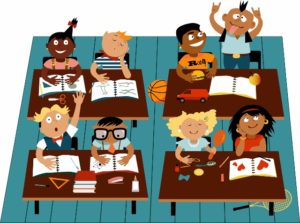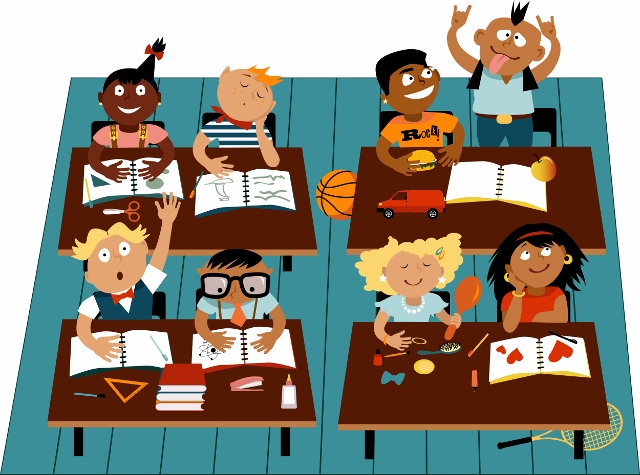

One challenge for teachers in all disciplines is working with a group that includes reluctant readers and writers along with gifted students. It is difficult to ensure that your curriculum appeals to students at all levels of differentiation and passion.
Students at all writing levels benefit from learning to create graphic novels and comics
Using comics or graphic novels can pique student interest in a variety of topics. A writing workshop that encourages students to craft a graphic novel or comic can result in a significantly deeper understanding of content while at the same time engaging a differentiated classroom.
Because they combine images and text, comics are a multimodal form of communication that can increase students’ understanding of nuanced writing techniques. Organizing a story on the page ensures that students make complex decisions about managing their ideas, concepts and overall plot in a way no standard writing outline can. This genre also helps students learn how to make and create inferences between text and image, an incredibly important skill to the task of critical thinking.
Writing a comic or graphic novel forces students to re-imagine content
When given a comic blank, a box of markers, and some time, students are forced to re-imagine content in a creative way, which means the workshop can be a fun break that reinforces student learning without focusing on rote memorization or busywork. As students find new ways to communicate material, there is a good chance their work may enhance their classmates’ understanding of core content or important features of writing that they may have otherwise missed.
Teacher prep for a workshop on creating comics
To prepare for a comic writing workshop, it can help to have some basic understanding of their educational value. The National Council for Teachers of English’s article “Using Comics and Graphic Novels in the Classroom” or the Pop Culture Classroom website are excellent sources for this.
Introducing students to comics or graphic novels is helpful as well, though it’s likely most of them are already familiar with the medium. You may want to collect some research materials in your content area that would be helpful to students. Consider whether you want them to be able to do research while creating their panels as well.
Important decision: Should students use pen and paper or computers?
Workshop instructors must also decide whether they want students to create their comics on paper or on the computer. For computer-based composition, students can use basic art programs or the Comic Creator found at ReadWriteThink.
If you prefer paper, there are a variety of printable comic panels available online. While computer-based work has the benefit of internet access and some pre-drawn artwork, there are definitely benefits to forcing a tech break and equipping students with the basics: pencil, pen, and markers.
Preparing students for a comics-writing workshop
While this workshop can be a fun surprise for students, it may be helpful to give them a heads-up that they’ll be having an art day/comic-writing seminar. Students who enjoy art will be excited about the idea, but others may be intimidated by the addition of a graphic component to their writing.
Humor, nonfiction and fantasy: Comics and graphic novels to inspire students
Bring excerpts of graphic novels and comics to display in class so students can experience a variety of artists and formats. Workshop participants would benefit from seeing comic strips like “Peanuts,” “Calvin and Hobbes” and “The Boondocks,” an entry from a popular comic book series such as X-Men or The Avengers, and grade-appropriate graphic novels in several genres.
Good graphic novels for middle and high school students
Highly-regarded graphic novels that are suitable for middle-school students include these titles:
- “The Arrival” by Shaun Tan
- “Smile” by Raina Telgemeier
- “Coraline” by Neil Gaiman
Award-winning graphic novels appropriate for students in high school include:
- “Rapunzel’s Revenge” by Shannon Hale
- “Batman: The Dark Knight Returns” by Frank Miller
- “The Complete Persepolis” by Marjane Satrapi
- “The Absolutely True Diary of a Part-Time Indian” by Sherman Alexie has more text than a traditional graphic novel, but is still a great example of comics in storytelling
A note on web comics
Instructors who are fans of web comics such as “Hyperbole and a Half” and “The Oatmeal” might consider including this genre in examples for students. However, since most web comics are written for an adult audience, teachers should ensure their choices contain classroom-appropriate language.
Whether the style is classic superhero adventure, comedy, sci-fi, or historical fiction, seeing a variety of comics can help students understand that perfect realism isn’t the goal and that stick figures are just as acceptable as high-quality graphics, so long as the images help communicate student ideas.
Kicking off a cross-curricular comics and graphic novel workshop: Challenges for English, social studies and science topics
On the day of the workshop, arm students with your challenge, which will vary by discipline. For example, a writing class could be tasked with creating an informational or persuasive comic panel, explaining an important technique they learned in class, or coming up with a purely creative short story.
Tasks for a social studies course could challenge students to recreate a certain time period or event in an informational or creative format. For the sciences, students can be challenged to illustrate the life cycle of an animal or plant, write a comic about another planet, or explain a scientific principle to their classmates.
Create writing groups to brainstorm and review
After giving them a challenge, break the class into smaller writing groups. They can create individual comics, but will use their group for brainstorming and peer review. You may consider devising several challenges so that different groups have different tasks. This will create interesting variety in their final products. After about 10 minutes of brainstorming to sketch out their intentions, have students discuss their ideas in groups.
Individual work sessions should include time prompts
After students have time to exchange ideas, allow them to work on their creations individually, but help them manage time with a 10-minute warning toward the end. This gives participants an opportunity to review their work for clarity and perhaps even exchange with a group member.
Sharing work with fellow writers and artists
At the end of the workshop, create space for students to share their comics with each other. The comic panels can be displayed for the entire group for a gallery-style party or students can pair and share.
Wrapping up comics writing: Reflection on the creative process
Students should leave a comic workshop with a deeper understanding of the content they have explored and how it can best be communicated to an audience. This workshop should be followed by a reflection — via class discussion or journal entry — of how creating in a multimodal format helped students understand core content, or perhaps how having to explain content to others clarified previous misunderstandings.
In addition to a significant metacognitive gain, students will also have a comic or mini-graphic novel, a finished piece of artwork that expresses their learning in a distinct and distilled form.
Monica Fuglei is a graduate of the University of Nebraska in Omaha and a current faculty member of Arapahoe Community College in Colorado, where she teaches composition and creative writing.
Categorized as: Tips for Teachers and Classroom Resources
Tagged as: Art, High School (Grades: 9-12), Language Arts, Middle School (Grades: 6-8)
